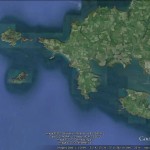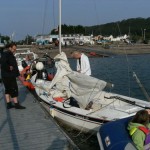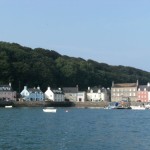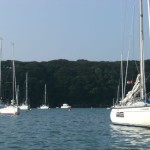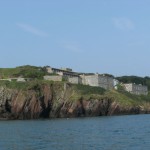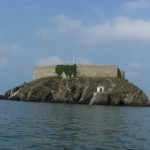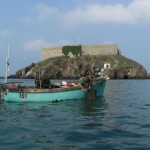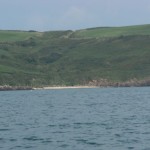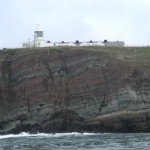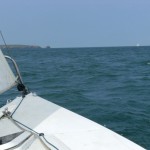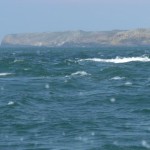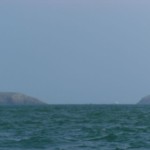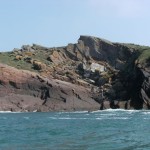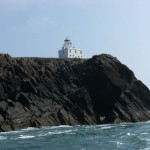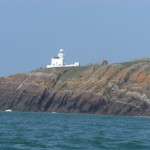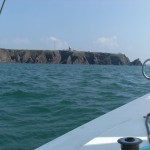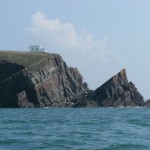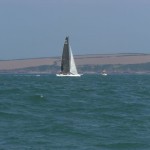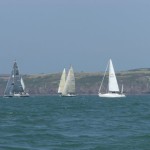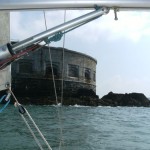When the balmy days of summer arrive in Pembrokeshire, the world is a warm friendly place and winter gales and rain are but a memory. The sea beckons and sail boats appear on the long flooded estuary of the Milford Haven waterway beneath blue skies with fluffy white clouds. It is a time to get out on the water. One option is to contract a days sail. My son Peter and I did this in August 2013. We contacted Brian Thomas who I knew in school days. Brian has a business refurbishing sailing boats and once operated a summer business of taking visitors by sail boat (a Drascombe lugger) along the waterway and out to Skomer Island. We planned a day sail to the islands on August Bank holiday (The islands of Skolkholm and Skomer lie off the western end of the Dale Peninsula). The day before was sunny but with a strong blustery wind and our family (including a new grandson) spent the day on sheltered Watwick Sands. The appointed day started clear and sunny but almost airless. We drove to Dale to meet on the pontoon there and found Brian ready with his 20 foot Hawk sailing boat. He was concerned at the lack of wind although the forecast was for force 3 and 4 that would have been perfect for a comfortable sail. As it was such a lovely day we decided to go ahead and see what could be achieved. So in very light northerly airs, we slowly threaded our way through the many yachts at their moorings off Dale village. We soon settled down with Brian as skipper, Peter on the tiller and I was free to make a photographic record for The Anchorage website to show visitors another local holiday activity.
Soon a light but intermittent breeze picked up off Dale Fort (where nature study courses are held) and we were able to sail across the two mile wide entrance of the waterway to arrive at Thorne Island with its Victorian Palmerston Folley fort (previously used as a hotel). In calm water we sailed around the island passing and greeting a lobster/crab fisherman who was winching up his pots on a long weedy line. Next we tacked back across the waterway to arrive off Watwick Sands. The northerly breeze picked up and we were able to run along the coast passing another Palmerston Folley – the West Blockhouse – to cross Mill Bay. This is an infamous black spot in the waterway. Long ago a submarine being towed broke loosed and was wrecked on the rocks near the blockhouse. More recently a boom defence vessel suffered the same fate and parts of her can be seen sticking out of the sand of Mill Bay at low tide. Most infamous was the giant crude oil tanker Sea Empress that ran aground on a shoal off Mill Bay and became a major oil spill incident. Much sea life and birds were killed off in this most major of accidents. Continuing west we passed beneath the white painted St. Ann’s lighthouse – now automated with the buildings as holiday apartments. The high sea cliffs here are made of Old Red Sandstone and consist of brightly coloured layers mainly red but some cream coloured.
Outside the waterway we picked up a good force 4 northerly breeze and tacked along the majestic and rugged cliff line towards Westdale Bay and Skomer Island. I photographed a tall red rock pinnacle rising out of the cliffs that was capped with yellow lichen. But the earlier light airs had delayed us and the tide had turned with the flood moving north. So we headed instead due west to Skolkholm Island. The distance from St Anne’s Head is around 5miles and Brians Hawke 20 sailed magnificently running along at about 6 knots. She is a fine sea boat and had been surprisingly manoeuvrable in the earlier light airs. It was a pleasant run across to Skolkholm on a single starboard tack, although the tide carried us to the northern end of the island. North of Skolkholm we shipped a few wave tops as we sailed across the Wildgoose tidal race. The west coast of Skolkholm was in sun shadow and little could be seen of the rocks Soon Skolkholm lighthouse on the south western tip of the island was visible and we turned along the very straight south side of the island. Here the sun shone on high cliffs revealing the same red and cream layering of the Old Red Sandstone as we had seen at St. Ann’s Head. A swell broke along the base of the cliffs but we were in the shelter of the high cliffs, so we opened our lunch box. Some beer and cider with leftover BBQ from the previous evening and some Cornish pasties went down very well in the warm sunshine as we admire the colours of the sea cliffs nearby. When we came out of the lee of the island we sailed on a port tack back towards St. Ann’s Head. On route we passed a few other sailing craft.
Skolkholm Island – named by Viking invaders – measures about one mile north-south and east-west with an area of 240 acres. It is flat topped (an old marine erosion surface) and around 150 feet high. It lacks trees and is famous for its bird population with 35,000 Manx shearwaters, 1000 storm petrels, 800 Lesser Black Backed gulls, 600 Herring Gulls as well as razorbill, guillemot, puffin colonies, oyster catchers, lapwings, skylarks, meadow and rock pipits and wheatears. Only ornithologists are permitted on the island (the Skolkholm Bird Observatory) where the accommodation is book up for some years in advance and there are no day visits for tourists. The Pembrokeshire islands were seized by the Normans and mainly used for summer grazing of sheep and cattle and winter catching of rabbits (the latter were introduced into Britain by the Normans). The island was farmed in the 18th and 19th centuries and the buildings remain.
Soon we were once again under the cliffs of St Ann’s Head and then crossing Mill Bay where we passed a launch with passengers engaged in mackerel fishing. On past Watwick Sands with the anchorage now in the afternoon crowded with sail and motor boats. We stayed on that port tack along the center of the Milford Haven Waterway as far as Stack Rock Fort – another Palmerston Folley – off Sandy Haven. The waterway between Dale and Stack Rock was crowded by yachts racing and temporary large yellow buoys marked the course. Most striking was a large trimaran that moved along much faster than any other yacht. Her triple hull held her rigidly upright and she sliced majestically through the water without pitching or rolling. Compared to the other monohull yachts, she looked like a real sea-going racing machine. Brian pointed out that the sheltered Milford Haven waterway made good sailing regardless of the weather. We sailed around Stack Rock and passed a pair of seals that live there. In the silence of our sailing craft, we could hear their loud calls to us as they watched us pass by. From there were able to return to Dale on a single starboard tack. We arrived back after some 6 hours of sailing after covering a distance of 22 miles. It had been a most pleasant and delightful day and we were delighted that the weather had cooperated with us.
Note: For those who like to sail Brian can be contacted by email at: family.williams22@btinternet.com
– John Roobol

